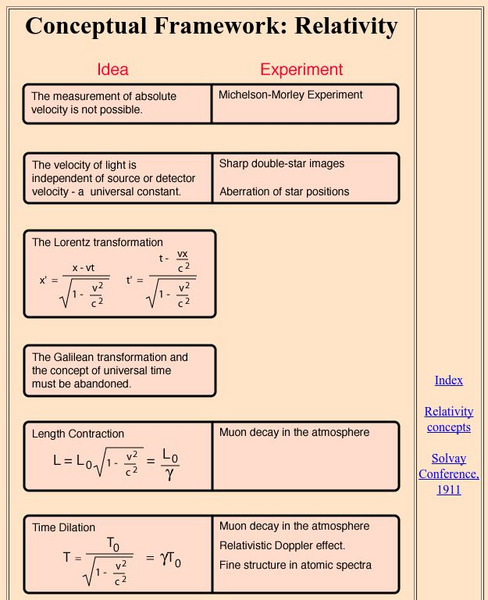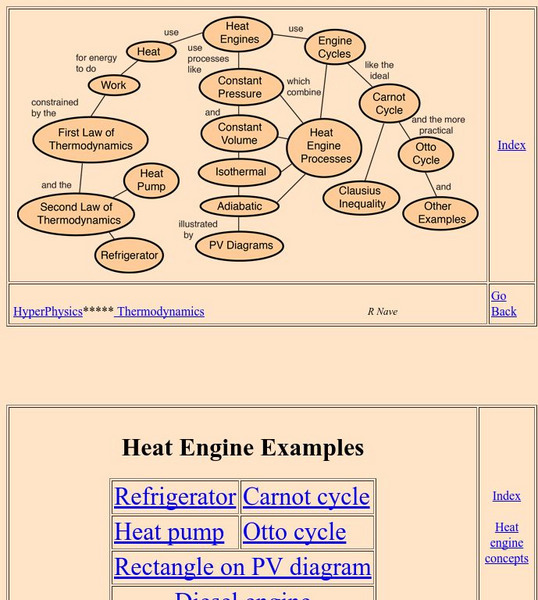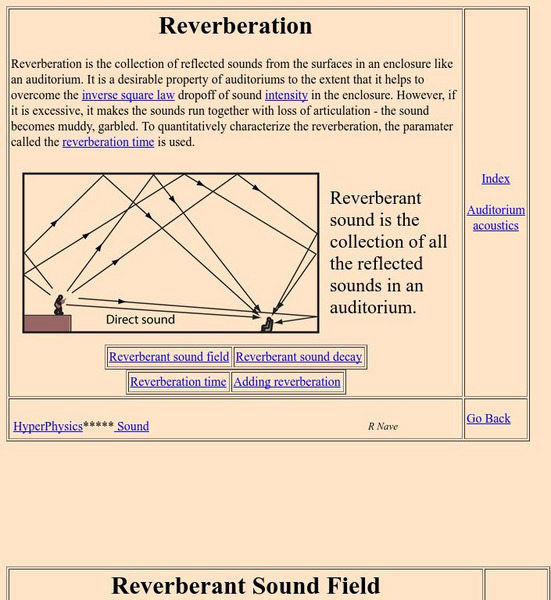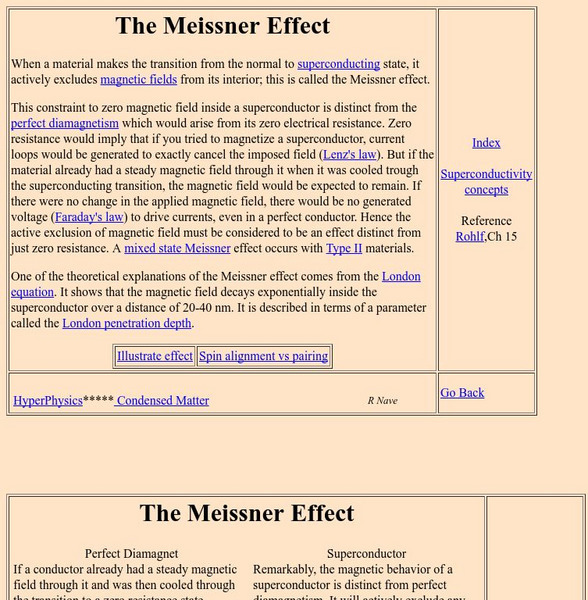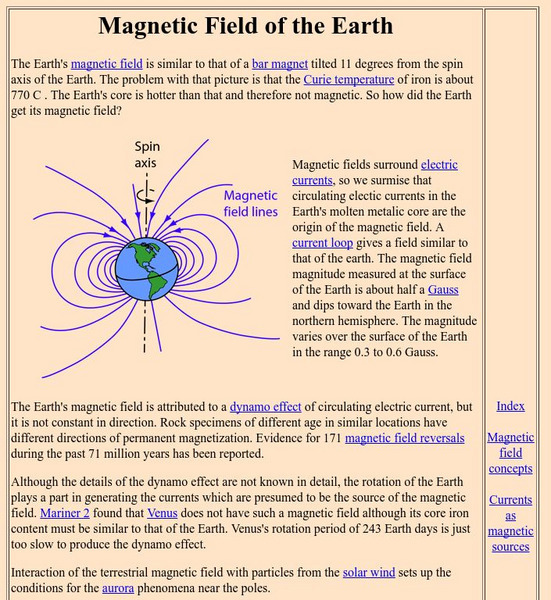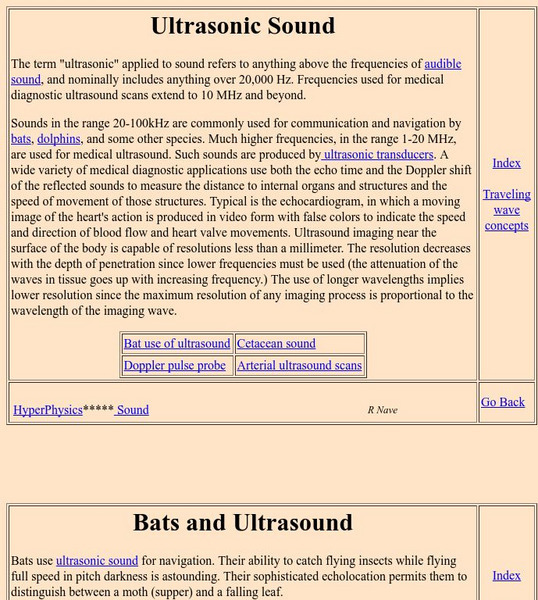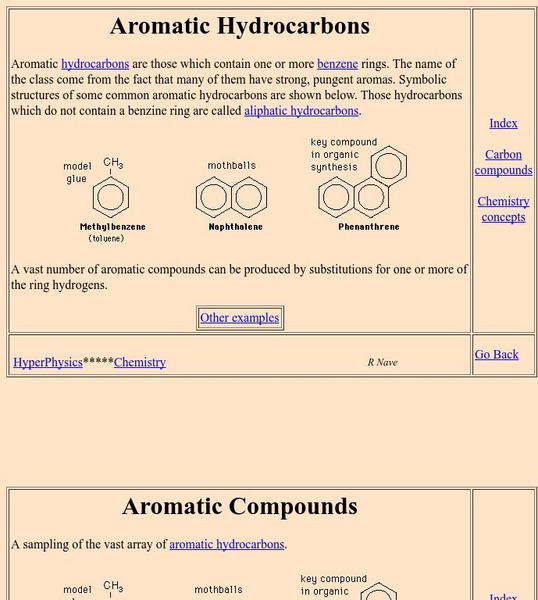Georgia State University
Georgia State University: Hyper Physics: Energy Cycle From Plants to Animals
Find out about the essential role energy plays in cell function and in sustaining life. Trace energy transformations as they pass from one living thing to another.
Georgia State University
Georgia State University: Hyper Physics: Ideal Gas Law Calculations
A page containing an interactive JavaScript form which allows the visitor to investigate the relationship between various state variables. Visitors input values of a few variables and observe the effect upon the other variables. Options...
Georgia State University
Georgia State University: Hyper Physics: Special & General Relativity
This site from the Georgia State University provides an interesting chart form of the ideas of relativity. Column 1 - Idea, Column 2 - Experiment. Each item is linked to its own page of explanation, which is well done. A nice type of...
Georgia State University
Georgia State University: Hyper Physics: Sound Propagation
This page and the many pages which are indexed to focus on the behaviors of sound which characterize it as a wave. Reflection, refraction, interference, diffraction and more are clearly illustrated and explained.
Georgia State University
Georgia State University: Hyper Physics: Relativistic Momentum
A clear (as these things go) presentation of the calculation of relativistic momentum. Given with a handy calculator that even calculates the % error. The site goes on to Momentum of a Photon, and to Relativistic Energy in Terms of...
Georgia State University
Georgia State University: Hyper Physics: Heat Engine Concepts
An indexing page for the HyperPhysics site. The page contains a concept map of links to a variety of other pages which discuss concepts related to heat engines. All pages contain informative graphics and excellent explanations.
Georgia State University
Georgia State University: Hyper Physics: Water Tube Resonance Experiment
Online physics lab experiment in which students use resonating waves inside of a closed-end air column to determine the speed of sound. The form allows students to check their answers and receive immediate feedback.
Georgia State University
Georgia State University: Hyper Physics: Reverberation
A tutorial from a hypertext physics course book that discusses reverberation. Illustrated.
Georgia State University
Georgia State University: Hyper Physics: Hund's Rules
A complete overview of Hund's rules including exceptions.
Georgia State University
Georgia State University: Hyper Physics: Hund's Rules
An excellent overview of Hund's Rules. Discusses all three rules thoroughly with provided diagrams.
Georgia State University
Georgia State University: Hyper Physics: The Meissner Effect
This site from the Georgia State University provides a good introduction to and illustration of the Meissner Effect, the property of a superconducting material whereby it actively excludes a magnetic field from within its interior.
Georgia State University
Georgia State University: Hyper Physics: The Auditory Nerve
A good description and function of the auditory nerve. Diagrams, explanations.
Georgia State University
Georgia State University: Hyper Physics: Sound Level Measurement
Home page for a hypertext physics course. Users can access subjects ranging from the sound wave parameters that effect hearing and communication to OSHA worplace standards.
Georgia State University
Georgia State University: Hyper Physics: Diffraction of Sound
This site's entry is a discussion of diffraction and its application to acoustics and acoustical design. Exceptional illustrations and great discussion throughout.
Georgia State University
Georgia State University: Hyper Physics: Refraction of Sound
A discussion of refraction and its application to sound waves. Using analogies, graphics and real-life applications, this page and those that accompany it explain why and when sound waves bend.
Georgia State University
Georgia State University: Hyper Physics: The Curie Temperature
A brief definition of the Curie temperature for ferromagnetic materials.
Georgia State University
Georgia State University: Hyper Physics: Diamagnetism
This site from the Georgia State University provides a brief introduction to diamagnetism, explaining how Lenz's law accounts for diamagnetic behavior in all materials.
Georgia State University
Georgia State University: Hyper Physics: Ionization Energies
A concise description of ionization energy, and a line graph that plots the ionization energies of the first 88 elements vs. the atomic numbers.
Georgia State University
Georgia State University: Hyper Physics: Precipitation Reactions
This site from Georgia State University discusses the precipitation reactions and deals with the lead iodide product. Links are provided to information on double replacement reactions as well as ionic compounds. Not too in-depth, this is...
Georgia State University
Georgia State University: Hyper Physics: Magnetic Field of the Earth
This site is a description of the earth's magnetic field, including a section on the "Dynamo effect," a proposed explanation for the origin of the earth's magnetic field.
Georgia State University
Georgia State University: Hyper Physics: Ultrasonic Sound
A brief explanation of what ultrasonic sound is and the devices that produce ultrasonic sound can be found here at the Georgia State University. Scroll down the page to read how ultrasonic sound is important to bats and towards the...
Georgia State University
Georgia State University: Hyper Physics: Thermal Conductivity
Lists thermal conductivity values for a variety of topics. The link "Heat conduction discussion" on this page displays an equation for calculating the rate of thermal conduction using these conductivity values.
Georgia State University
Georgia State University: Hyper Physics: Voltaic Cells
Georgia State University provides a technical discussion on how voltaic cells produce an external electric current. Equations for the reactions that occur are given and discussed.
Georgia State University
Georgia State University: Hyper Physics: Aromatic Hydrocarbons
A definition for an aromatic hydrocarbon is given, along with examples, that show the structure of common aromatic hydrocarbons.




